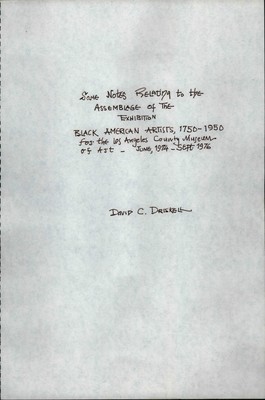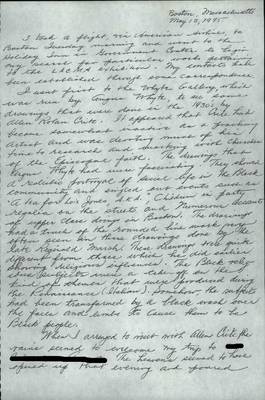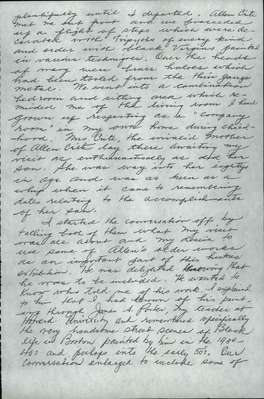Pages
MS01.03.03.B11.F15.0001
Some Notes Relating to the ASSEMBLAGE of The EXHIBITION BLACK AMERICAN ARTISTS, 1750 - 1950 for the Los Angeles County Museum of ART - June 1974 - Sept. 1976
DAVID C. DRISKELL
MS01.03.03.B11.F15.0002
[Illustration: Window in My Office] In Mid April, 1974, I had a telephone call from Rexford Stead, Deputy Director of the Los Angeles County Museum of Art telling me of plans that had been discussed to arrange for a Bicentennial Exhibition at the L.A.C.M.A that would be historical in nature and comprehensive enough in format to broadly index many of the major works in painting, sculpture, the graphic arts and the crafts that had never been assembled in one exhibition prior to this time. We talked about the good of such a show in bringing to the public an important segment of American culture not too well known to the majority culture of the West Coast. But it was equally stressed that the format of the exhibition should lend itself to the learning experiences of all Americans. It was assumed that many Black Americans would already be familiar with much of the content of the show. No special emphasis was placed on content during the conversation at hand. We decided to leave the idea open until such time that I could survey my own time and really think about the project. We talked a few other times during the month of May after which a number of letters ensued. It was mid-June before I went to Los Angeles to talk with museum officials about the project. By this time, Summer had come along and I was busy catching up with the summer work at the place in Falmouth, Maine -- which included gardening among many other things. I travelled to the L.A.C.MA on June 12 to make a presentation to the board about the feasibility of the exhibition. I presented a proposal which summarize the basis of the project to the full board of the Museum and it was well received.
MS01.03.03.B11.F15.0003
[Illustration on right-hand corner of letter depicting a head being surrounded by a pen, an inkwell and "sign sign sign sign" written across the botton while a curlique scroll says "Sign No!"] I had to return to Maine by way of Boston. Several conversations ensued including various correspondences of different types about the contract that I had been asked to sign by the LACMA. I delayed signing until late September as I wanted to be certain that all legal matters had been taken care of in the one sent. MY LAWYER IN FREEPORT, ME had already looked over the document sent by LACMA and advised that I should have a more clearly written document presented before agreeing to sign. Another document was prepared by the museum which read to my satisfaction with a rearranged pay schedule given. I signed it mid October and began the general work of writing known sources of art for the show. Several letters were sent out to artist whom I knew would be interested in showing. I made my first official trip to select work and single out advice in mid November. I went to New York City to consult with artist there. On November [blank], I visited Hale Woodruff at his "Village" residence and viewed a number of current drawings and earlier paintings. He explained about his health and the pace at which he then worked in contrast to his youthful years. While I was at his residence, where he maintains a small studio, I was able to acquire a charcoal drawing called "Torso" for the Fisk University collection. He gave very sound advice about the organizational structure of such a show as the one I was organizing. [Illustration at left lower corner of the letter depicts three faces] Hale Woodruff did several compositions in the 1950s which had African art related themes. He owns a fine small collection which is displayed in his studio. He told of how he [,] Spinkey Alston, Romare Bearden and other Black artists in the New York area got together and organized the Spiral Group in the late 1950s - early 60s.
MS01.03.03.B11.F15.0005
Boston, Massachusetts May 13, 1975
I took a flight, via American Airlines, to Boston Tuesday morning and went to the Holiday Inn in Government Center to begin my search for particular works pertaining to the LACMA exhibition. My contacts had been established through some correspondence.
I went first to the Whyte Gallery, which was run by Angus Whyte, to see some drawings that were done in the 1930's by Allen Rolan Crite. It appeared that Crite had become somewhat inactive as a practicing artist and was devoting much of his time to research and working with churches of the Episcopal faith. The drawings that Angus Whyte had were fascinating. They showed a realistic portrayal of social life in the Black community and singled out events such as "A tea for Lois Jones, A.K.A.," Children in party regalia on the streets and numerous accounts of upper class doings in Boston. The drawings had a touch of the rounded line work very often seen in those drawings done by the late Reginald Marsh. These drawings were quite different from those which he did earlier showing religious influences. The Black religious subjects were a take-off on the kind of themes that were produced during the Renaissance (Italian). Somehow, the subjects had been transformed by a black wash over the faces and limbs to cause them to be Black people.
When I arranged to visit with Allen Crite the rains seemed to welcome my trip to [REDACTED]. The heavens seemed to have opened up that evening and poured
MS01.03.03.B11.F15.0006
plentifully until I departed. Allen Crite met me out front and we proceeded up a flight of steps which were decorated with triptychs of every kind and order with black Virgins painted in various techniques. Over the heads of many were brass haloes which had been tooled from the thin gauge metal. We went into a combination bedroom and sitting area which reminded me of the living room I had grown up respecting as a "company room" in my own home during childhood. Mrs. Crite, the invalid mother of Allen Crite lay there awaiting my visit as enthusiastically as did her son. She was way into her eightys [eighties] in age and was as keen as a whip when it came to remembering dates relating to the accomplishments of her son.
I started the conversation off by telling both of them what my visit was all about and my desire to use some of Allen's older works as an important part of this historic exhibition. He was delighted knowing that he was to be included. He wanted to know who told me of his work. I explained to him that I had known of his painting through James A. Porter, my teacher at Howard University and remembered specifically the very handsome street scenes of Black life in Boston painted by him in the 193040s and perhaps into the early 50's. Our conversation enlarged to include some of






